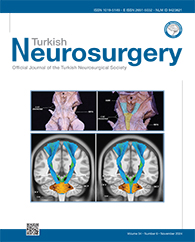2Ankara University Faculty of Medicine, Department of Neurosurgery, Ankara, Türkiye
3Gaziantep University Faculty of Medicine, Department of Anatomy, Gaziantep, Türkiye
4Istanbul Medipol University School of Vocation, Department of Medical Laboratory Techniques, Istanbul, Türkiye
5Silivri Anadolu Hospital, Department of Neurosurgery, Istanbul, Türkiye DOI : 10.5137/1019-5149.JTN.45482-23.2 AIM: To examine the morphological properties of the cranial aperture of the optic canal (CAOC) in patients with a Chiari type-I malformation (CIM).
MATERIAL and METHODS: Radiological images of 40 patients with CIM (24 females/16 males, mean age: 20.75 ± 14.98 years) and 40 normal individuals (24 females/16 males, mean age: 23.13 ± 18.89 years) were included in the study to assess the anatomical features of CAOC.
RESULTS: The CAOC width (p=0.137), CAOC height (p=0.243), distance between the CAOC and the midsagittal line (p=0.982), and angle of the optic canal in the sagittal plane (Ang-in-SP) (p=0.598) were similar in patients with CIM and in the controls. The distances between the CAOC and the anterior (Dis-to-AB) and lateral (Dis-to-LB) boundaries of the anterior skull base were smaller in patients with CIM than in the controls (p<0.01). However, the angle of the optic canal in the axial plane (Ang-in-AP) was greater in patients with CIM than in the controls. Four different aperture shapes were identified in the CIM group (teardrop, n=42 [52.40%]; triangular, n=17 [21.30%]; oval, n=9 [11.30%]; and round, n=12 [15%]) and in the control group (teardrop, n=36 [45%]; triangular, n=14 [17.50%]; oval, n=10 [12.50%]; and round, n=20 [25%]).
CONCLUSION: A greater Ang-in-AP and shorter Dis-to-LB and Dis-to-AB were found in patients with CIM than in the healthy controls. The distance measurements demonstrate that patients with CIM have a shorter and narrower anterior fossa than normal individuals.
Keywords : Optic canal, Cranial aperture, Computed tomography, Chiari type-I malformation, Morphometric, Transcranial approaches




